Target Bundle
Can Target's Growth Strategy Outpace the Retail Revolution?
Target, a retail giant with a rich history dating back to 1902, is constantly navigating the ever-evolving retail landscape. From its inception as an "Upscale Discount" retailer, Target has consistently adapted, growing into one of the largest companies in the United States. This Target SWOT Analysis provides a comprehensive overview of the company's current standing and future trajectory.
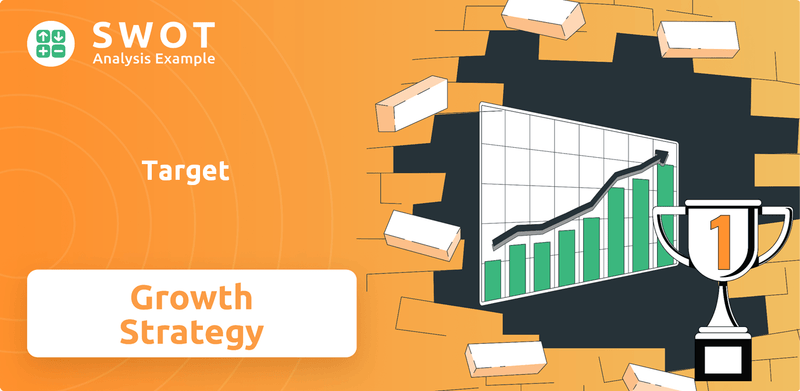
Understanding Target's growth strategy is crucial for investors and business strategists alike. This analysis delves into the Target company analysis, exploring its future prospects and strategic initiatives aimed at driving significant sales growth. We'll examine how business development and strategic planning are shaping Target's market position in a competitive environment, providing insights into its long-term sustainability and potential for growth.
How Is Target Expanding Its Reach?
The company's growth strategy focuses on expanding its market presence and diversifying revenue streams. This involves both physical and digital expansions, alongside category and product line enhancements. The company is actively working to reach new customers and increase sales across various channels.
A key aspect of this strategy is the physical expansion, which includes opening new stores and remodeling existing ones. Simultaneously, there's a strong emphasis on growing the digital presence and enhancing customer loyalty programs. These initiatives are supported by strategic partnerships and investments in key product categories.
The company's strategic goals and objectives are centered on long-term sustainable growth and market leadership. This approach aims to strengthen its market position and capitalize on emerging opportunities in the retail industry. The company's expansion plans are designed to meet evolving consumer demands and maintain a competitive edge.
The company plans to open over 300 new stores in the next decade. Approximately 20 new stores are planned for 2025, with a focus on larger formats. Extensive remodels of existing locations are also underway, enhancing the shopping experience.
The company aims to grow its Target Plus marketplace significantly. The goal is to increase third-party digital sales from approximately $1 billion in 2024 to over $5 billion by 2030. Hundreds of new brands will be added to the platform.
The company is committed to doubling the size of its in-house media company, Roundel, by 2030. Roundel generated over $2 billion in value in 2024. This expansion will enhance the company's advertising and marketing capabilities.
The company is enhancing its Target Circle loyalty program. The goal is to triple its Target Circle 360 membership base over the next three years. New perks and partnerships, including one with Marriott Bonvoy, will be introduced.
The company's expansion initiatives are designed to drive sustainable growth. These initiatives include physical and digital expansions, product category enhancements, and strategic partnerships. For more insights into the company's marketing approach, you can read about the Marketing Strategy of Target.
Starting in 2025, key categories like gaming, sports, toys, and home goods will be reimagined. This includes offering new and expanded assortments to meet evolving consumer demands. The company's food and beverage sales were $23.83 billion in the fiscal year ended February 1, 2025.
- Expanding beauty offerings and boosting private brands, especially in food and beverage.
- Opening new food distribution centers to support growth.
- The company has opened three new food distribution centers in the last two years.
- A ninth facility is slated to open in 2026.
Target SWOT Analysis
- Complete SWOT Breakdown
- Fully Customizable
- Editable in Excel & Word
- Professional Formatting
- Investor-Ready Format
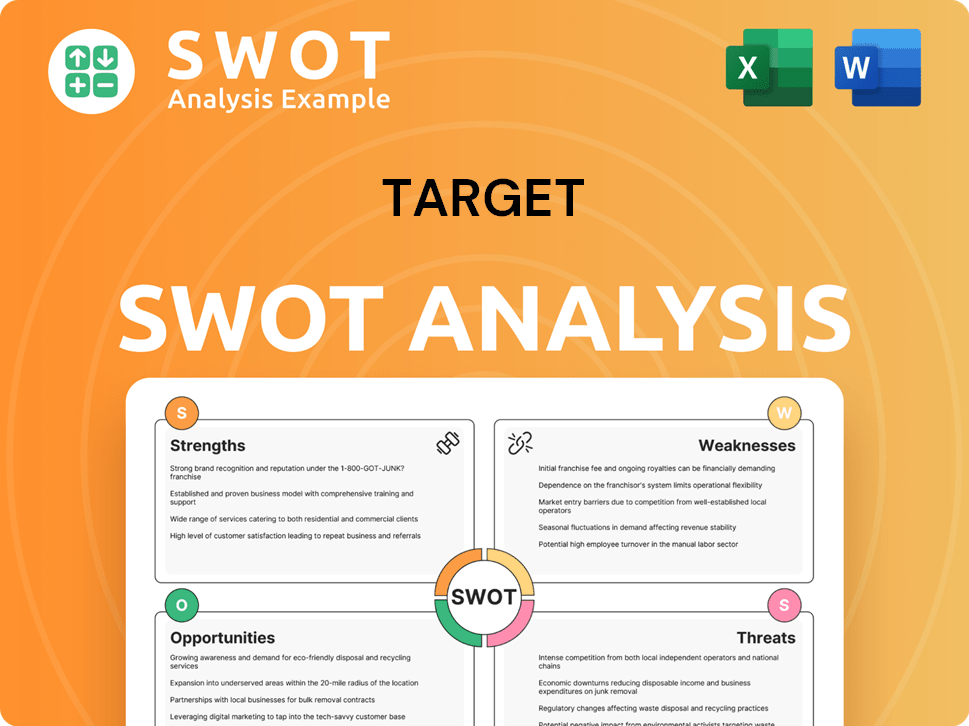
How Does Target Invest in Innovation?
The company's growth strategy heavily relies on technology and innovation, focusing on digital transformation and the integration of cutting-edge technologies. This approach aims to enhance customer experiences and streamline operations. The company plans to invest a significant amount in stores, supply chain, and technology in 2025 to support these initiatives.
A key element of this strategy is improving the digital experience through innovations in search, social commerce, and data-driven personalization. The company is also leveraging artificial intelligence (AI) to offer more relevant product recommendations and optimize search results. These efforts are designed to boost online sales and improve customer satisfaction.
The company's commitment to sustainability and its investments in Black-owned businesses also contribute to its growth strategy. These initiatives align with evolving consumer preferences and support long-term business development. For more information about the company, you can read the article about Owners & Shareholders of Target.
The company is enhancing its digital experience through innovations in search, social commerce, and data-driven personalization. This includes using AI to offer more relevant product recommendations. These improvements are aimed at increasing online sales and customer engagement.
Artificial intelligence (AI) plays a crucial role in the company's strategy. AI is used to optimize search results and integrate with social media trends. The company has been using AI models for over a decade to improve efficiency and personalize customer experiences.
The company is transforming its supply chain for increased efficiency, speed, and capacity. This includes new package delivery solutions and next-day delivery through its Shipt business. These improvements enhance the speed and reliability of same-day services.
The company is committed to sustainability, aiming to make all of its own-brand plastic packaging recyclable, compostable, or reusable by 2025. In 2023, they reached 32%, up from 22% in 2022. This focus aligns with growing consumer demand for eco-friendly products.
The company is investing over $2 billion with Black-owned businesses by 2025. Since 2020, these investments have increased by more than 50%. This commitment supports economic growth and reflects the company's values.
The company plans to invest between $4 billion to $5 billion in stores, supply chain, and technology in 2025. This investment underscores their commitment to growth and innovation. These investments are crucial for the company's future market trends and expansion plans.
The company's growth strategy is multifaceted, focusing on digital transformation, supply chain optimization, and sustainability. These initiatives are designed to enhance customer experience, improve operational efficiency, and support long-term growth. The company's strategic goals and objectives are clearly defined and supported by significant investments.
- Digital Transformation: Enhancing the digital experience through innovations in search, social commerce, and data-driven personalization.
- AI Integration: Utilizing AI for product recommendations, search optimization, and operational efficiency.
- Supply Chain Optimization: Improving speed and reliability of same-day services and next-day delivery. Same-day services like Drive Up and Same-Day Delivery saw over 25% growth in the fourth quarter of 2024 and more than 35% growth in Q1 2025, powered by Target Circle 360.
- Sustainability: Committing to recyclable, compostable, or reusable packaging by 2025.
- Investment in Black-Owned Businesses: Investing over $2 billion by 2025.
Target PESTLE Analysis
- Covers All 6 PESTLE Categories
- No Research Needed – Save Hours of Work
- Built by Experts, Trusted by Consultants
- Instant Download, Ready to Use
- 100% Editable, Fully Customizable
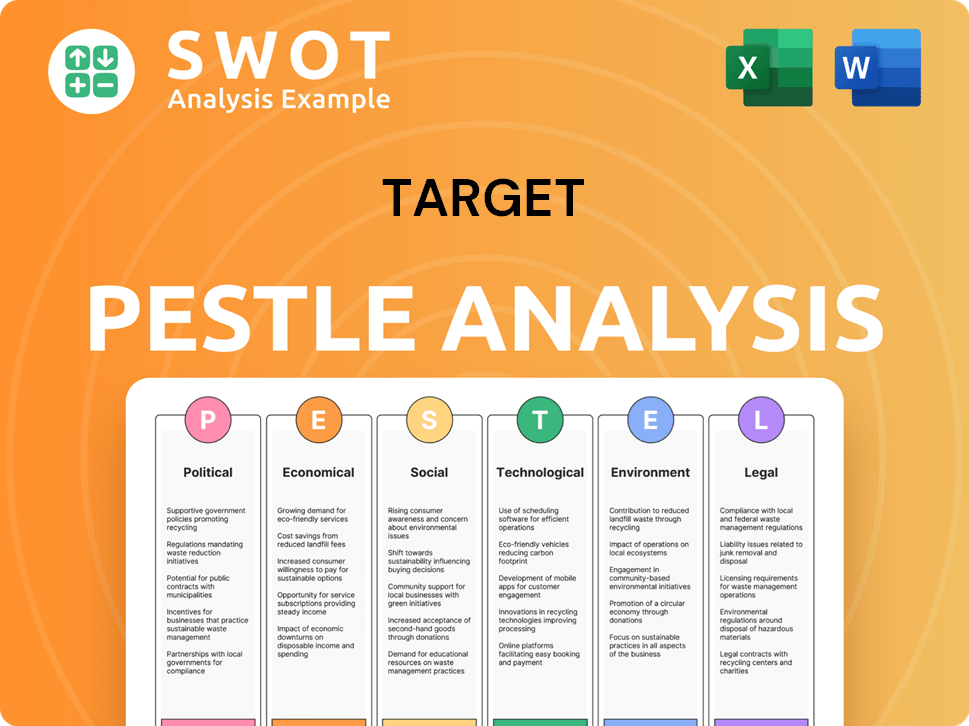
What Is Target’s Growth Forecast?
The financial outlook for Target in 2025 reflects a cautious approach, influenced by ongoing economic uncertainties and competitive pressures within the retail sector. The company's performance in fiscal year 2024 showed a slight decrease in net sales, with comparable sales experiencing modest growth. While the initial projections for 2025 were positive, the actual results from the first quarter prompted a revision of the full-year outlook.
Target's strategic planning for future growth is significantly impacted by these financial realities. The company is navigating challenges related to consumer spending habits, tariff impacts, and the timing of certain costs. These factors contribute to the revised expectations for the year, which now anticipate a decline in sales and adjusted earnings per share.
The revised financial forecasts necessitate a deeper Target Market of Target analysis to understand the implications for business development and strategic planning. The company's ability to adapt to changing market dynamics and consumer preferences will be crucial for achieving its long-term growth objectives.
Target reported net sales of $106.6 billion, a 0.8% decrease from the previous year. Full-year comparable sales grew by 0.1%. GAAP and Adjusted EPS for 2024 were $8.86.
Initially, Target expected net sales growth of around 1% and GAAP and Adjusted EPS of $8.80 to $9.80 for fiscal year 2025. This outlook was provided before the Q1 2025 results.
Q1 2025 net sales were $23.8 billion, a 2.8% decrease from Q1 2024. Comparable sales declined by 3.8%. GAAP EPS was $2.27, and Adjusted EPS was $1.30.
Target now anticipates a low-single-digit decline in sales for the full year 2025. Adjusted earnings per share are projected to be between $7.00 and $9.00.
The revised financial outlook underscores the importance of understanding the factors influencing Target's growth strategy. The company's ability to manage costs and adapt to market changes will be critical.
- Consumer Uncertainty: Economic conditions significantly impact consumer spending.
- Tariff Impacts: These influence the cost of goods and overall profitability.
- Cost Timing: The timing of certain costs affects short-term financial performance.
- Operating Income: Q1 2025 operating income was $1.5 billion, up 13.6% from last year, benefiting from a $593 million pre-tax gain from a credit card interchange fee litigation settlement. Excluding this settlement, the operating income margin rate was 3.7% in Q1 2025, compared to 5.3% in Q1 2024.
Target Business Model Canvas
- Complete 9-Block Business Model Canvas
- Effortlessly Communicate Your Business Strategy
- Investor-Ready BMC Format
- 100% Editable and Customizable
- Clear and Structured Layout
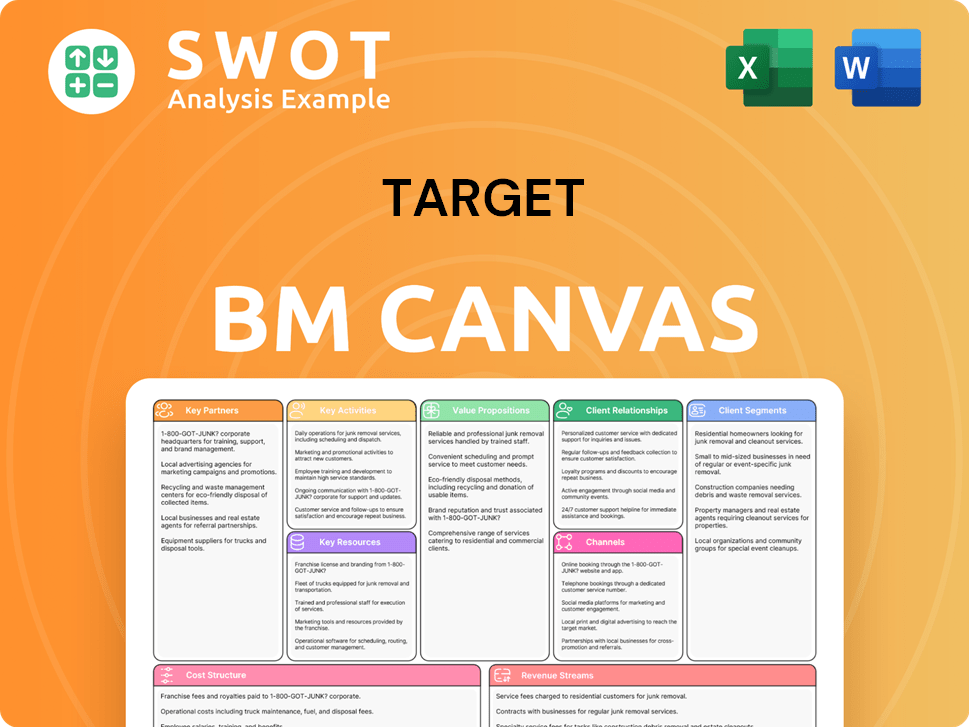
What Risks Could Slow Target’s Growth?
The growth strategy of the company faces several potential risks and obstacles that could impact its future prospects. Intense market competition, especially from major rivals, and shifting consumer preferences present ongoing challenges. Understanding these risks is crucial for conducting a thorough Target company analysis and assessing its long-term viability.
Regulatory changes and supply chain disruptions further complicate the business environment. These factors, coupled with the need for continuous technological adaptation and internal resource constraints, create a complex landscape. The ability to navigate these challenges will be critical for the company's business development and maintaining a strong market position.
The company's strategic goals and objectives are constantly tested by external pressures and internal operational considerations. The company must proactively address these challenges to sustain its growth trajectory. A deep dive into the company’s expansion plans and financial performance is essential to understand its resilience.
Competition from retailers like Walmart and Amazon poses a significant threat. The company lost market share in 20 out of 35 broad product divisions. This intense competition puts pressure on pricing and profitability, impacting the company's overall growth strategy.
The company has experienced pressure on sales in discretionary categories. These categories saw a collective decline of 5% in Q1 2025. This decline impacts both traffic and average transaction amounts, affecting the company's revenue and financial performance.
Regulatory changes in labor laws, data privacy, and environmental regulations can impact operations. The company must adapt to these changes to avoid penalties and maintain compliance. These changes can add to operational costs and complexity.
Supply chain disruptions can affect product availability and margins. Efforts to reduce virgin plastic use by 2025 have been slowed by supply chain constraints. These constraints can lead to increased costs and reduced profitability.
The need for continuous investment in digital capabilities is essential to remain competitive. This requires ongoing expenditure on technology and infrastructure. Failure to adapt can lead to a loss of market share and reduced growth.
Managing costs and maintaining efficiency are critical factors. In Q4 2024, operating income decreased by 21.3% due to higher digital fulfillment and supply chain costs. Effective cost management is vital for sustainable growth.
The company has implemented strategic initiatives to address these risks. Ongoing efficiency efforts have delivered over $2 billion in cost savings over the last two years. The company is actively working to improve operational efficiencies and drive cost savings through its Enterprise Acceleration Office, led by COO Michael Fiddelke.
The company's wide financial guidance range for 2025 reflects the added uncertainty from potential tariffs. The company has cited a negative reaction to its rollback of diversity, equity, and inclusion initiatives as a contributing factor to recent performance. This demonstrates the impact of external factors on the company's growth.
Target Porter's Five Forces Analysis
- Covers All 5 Competitive Forces in Detail
- Structured for Consultants, Students, and Founders
- 100% Editable in Microsoft Word & Excel
- Instant Digital Download – Use Immediately
- Compatible with Mac & PC – Fully Unlocked
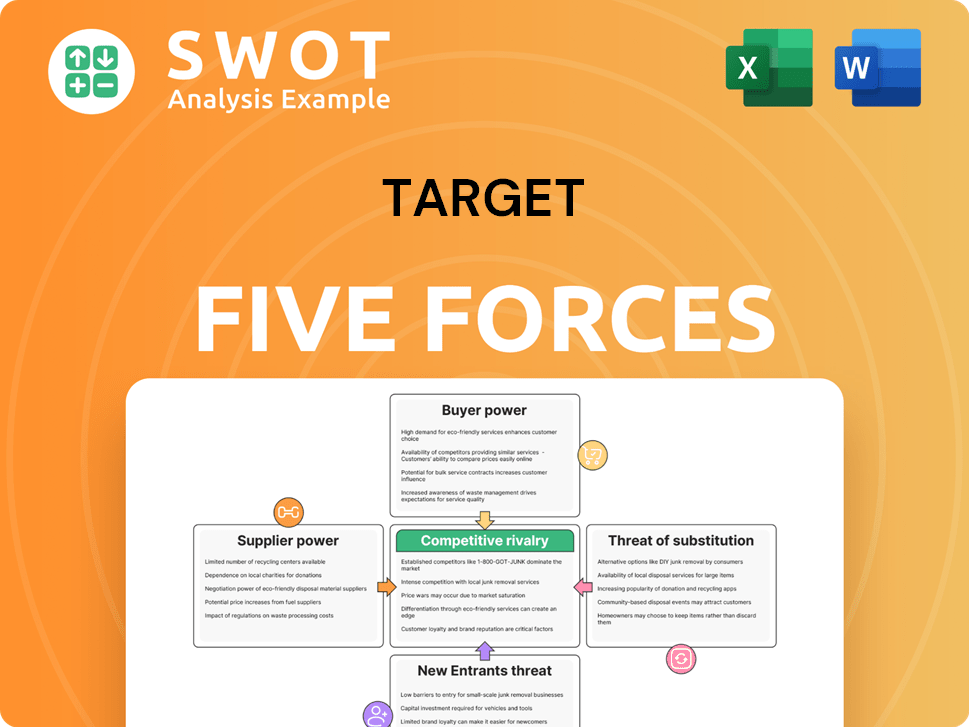
Related Blogs
- What are Mission Vision & Core Values of Target Company?
- What is Competitive Landscape of Target Company?
- How Does Target Company Work?
- What is Sales and Marketing Strategy of Target Company?
- What is Brief History of Target Company?
- Who Owns Target Company?
- What is Customer Demographics and Target Market of Target Company?
Disclaimer
All information, articles, and product details provided on this website are for general informational and educational purposes only. We do not claim any ownership over, nor do we intend to infringe upon, any trademarks, copyrights, logos, brand names, or other intellectual property mentioned or depicted on this site. Such intellectual property remains the property of its respective owners, and any references here are made solely for identification or informational purposes, without implying any affiliation, endorsement, or partnership.
We make no representations or warranties, express or implied, regarding the accuracy, completeness, or suitability of any content or products presented. Nothing on this website should be construed as legal, tax, investment, financial, medical, or other professional advice. In addition, no part of this site—including articles or product references—constitutes a solicitation, recommendation, endorsement, advertisement, or offer to buy or sell any securities, franchises, or other financial instruments, particularly in jurisdictions where such activity would be unlawful.
All content is of a general nature and may not address the specific circumstances of any individual or entity. It is not a substitute for professional advice or services. Any actions you take based on the information provided here are strictly at your own risk. You accept full responsibility for any decisions or outcomes arising from your use of this website and agree to release us from any liability in connection with your use of, or reliance upon, the content or products found herein.